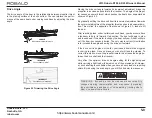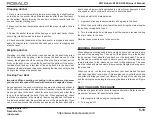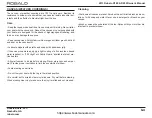
2013 Robalo R180 & R200 Owner’s Manual
Robalo Boats, LLC
Nashville, GA
robalo.com
5-8
Drive Angle
The drive angle of the boat is the relationship between propeller thrust
to the planing surface of the hull’s bottom. You can improve the perfor-
mance of the same boat under varying conditions by adjusting the drive
angle.
CORRECT
Gives maximum performance
INCORRECT
Causes boat to "plow"
INCORRECT
Causes boat to "porpoise"
Figure 5.3 Trimming the Drive Angle
Moving the drive unit angle towards its innermost adjustment brings the
propeller in as close as possible to the transom. The angle ofthe propel-
ler causes an upward thrust which pushes the boat’s bow downward as
shown on Figure 5.3.
By gradually shifting the drive unit from its innermost adjustment towards
the outermost adjustment, the propeller thrust pushes in a downward mo-
tion. This motion, the opposite of that shown in Figure 5.3, tends to lift
the bow.
After reaching plane, under certain load conditions, your boat could have
a tendency to bury its forward V-ed section. The boat will begin to plow
and lose speed. If the water is choppy the boat will yaw. A boat will spin
out if its bow is excessively buried. The only way to correct this situation
is to increase the angle and swing the drive unit outward.
If the drive unit is angled out too far, your loaded boat will be sluggish
in coming to plane. Once on plane, your boat will tend to porpoise. To
correct this motion, move the propeller inward to decrease the angle be-
tween the drive shaft and the transom.
Very often, the optimum drive unit angle setting for the highest speed
while carrying a light load will be just short of the porpoise point. Howev-
er, such a setting is unsuitable when you have a heavy load or are pulling
skiers. By reducing the drive angle, you will
fi
nd it easier to maneuver.
W A
R
N
I
N
G
:
E
x
c
e
s
s
i
v
e
t
r
i
m
d
e
c
r
e
a
s
e
s
m
a
n
e
u
v
e
r
a
b
i
l
i
t
y,
changes
steering
characteristics,
and
m ay
cause
“porpoising”
(bow
oscillates
up
and
dow n)
or
“chine
w alking”
(rocking
side
to
side).
U se
pow er
trim
w ith
care.
https://www.boat-manuals.com/
















































